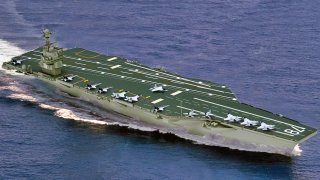Ford-Class USS John F. Kennedy: The Best U.S. Navy Aircraft Carrier?
The USS John F. Kennedy - a new U.S. Navy Aircraft Carrier of the Ford-Class - could end up being the best aircraft carrier America ever puts to sea.
Last month, the U.S. Navy’s program manager for the Ford-class aircraft carriers revealed that the upcoming USS John F. Kennedy (CVN 79) will become a unit of the U.S. Pacific Fleet when it makes its premiere deployment. As detailed by Captain Brian Metcalf, the second Gerald R. Ford-class ship should be delivered to the service sometime in 2025 and is nearly 90 percent complete at Hill’s Newport News shipyard. The lead ship of the Ford-class, USS Gerald. R Ford (CVN 78) recently made headlines when it was deployed by the Pentagon to the eastern Mediterranean Sea amidst the ongoing Israel-Hamas war. As the service’s latest and most advanced carrier class to ever sail the seas, the Ford carriers are expected to remain the backbone of the Navy for decades to come.
The Lead-Up To The Ford-Class Aircraft Carriers
Since the mid-1970s, the Nimitz-class carriers have embodied the Navy’s power projection strategy from the seas. These extraordinary ships displace about 100,000 tons when fully loaded and can sail at speeds in excess of 30 knots without needing to stop to resupply for more than three months. The Nimitz ships were initially designed to replace the Navy’s aging carriers including the Kitty Hawk, Forrestal, and Enterprise classes. Each Nimitz vessel is equipped with two nuclear reactors and can carry up to 90 percent more aviation fuel and 50 percent more ordnance compared to its predecessors.
Powered by nuclear sources instead of oil, these ships feature greater endurance and possess the ability to adjust weapons systems onboard. Notably, the Nimitz-class carriers can carry approximately 60 airframes, including a variety of fixed-wing and rotary-wing aircraft. These “floating airports” also incorporate the cutting-edge GPS-enabled aircraft carrier landing system called the Joint Precision Approach and Landing System, which aids in take-off and landing for pilots.
The Nimitz-class ships have proven to be formidable assets for the Navy since their introduction to service several decades ago. From the Cold War to Operation Enduring Freedom in Afghanistan and Operation Iraqi Freedom in Iraq, the Nimitz ships have a respectable operational history. However, the Navy is pouring its resources into a brand new carrier-class. Ford ships are designed to sport a range of enhancements that will come in handy as tensions between Beijing and Washington continue to mount in the South China Sea.
The Ford-Class, Specs & Capabilities
Although the Nimitz carriers have effectively accommodated a ton of new technologies over the years, this class of ships still struggles to support the most recent advancements.
As stated in a 2005 Rand report, "The biggest problems facing the Nimitz class are the limited electrical power generation capability and the upgrade-driven increase in ship weight and erosion of the center-of-gravity margin needed to maintain ship stability." The Gerald R. Ford class is designed to rectify this flaw. CVN 78, the lead ship of the class, was first ordered from Newport News Shipbuilding back in 2008 and has been in service with the Navy since 2018.
The Gerald R. Ford-class has hulls similar to their Nimitz predecessors, but they feature newer technologies with the CVN/CVN-21 program including the Electromagnetic Aircraft Launch System. Perhaps most significantly, the Ford-class ships can launch 25 percent more sorties than previous carriers and can generate triple the electrical power with improved efficiency. Specifically, the Ford can reach 160 sorties per day with the capacity to hit 270 in a wartime crunch. The existing Gerald R. Ford is the most sophisticated warship to ever exist and it is soon to be joined by the USS John F. Kennedy.
Introducing The USS John F. Kennedy
Huntington Ingalls Industries Northrop Grumman Shipbuilding was awarded a whopping $370-plus contract to begin design work and construction on the second Ford-class carrier back in 2009. While the ship was supposed to enter service with the Navy several years ago, various delays have set back this timeline. Most recently, the service delayed the John F. Kennedy’s delivery date from 2024 so that it could alter the ship’s Post Shakedown Availability.
As detailed by the U.S. Naval Institute, “This approach will prepare CVN 79 as the first FORD class aircraft carrier to operate in the Indo-Pacific region and decrease the amount of time CVN 79 would be required to be at the shipyard after ship delivery to conduct the PSA,” adding that “CVN 79s PSA will align to a traditional period of resolving discrepancies discovered during trials. The revised strategy maintains the overall ‘ready for deployment workups’ milestone for CVN 79.”
The Ford-class may represent the most expensive carrier program to ever take form, however, the staggering $120 billion platform will be by far the most capable of its kind to ever sail the seas.
About the Author
Maya Carlin is an analyst with the Center for Security Policy and a former Anna Sobol Levy Fellow at IDC Herzliya in Israel. She has by-lines in many publications, including The National Interest, Jerusalem Post, and Times of Israel. You can follow her on Twitter: @MayaCarlin.


